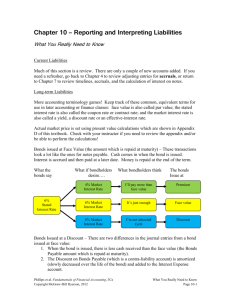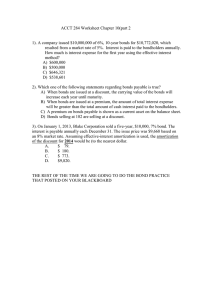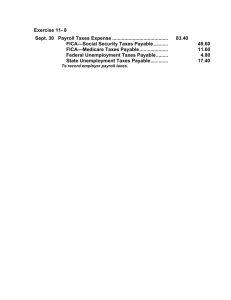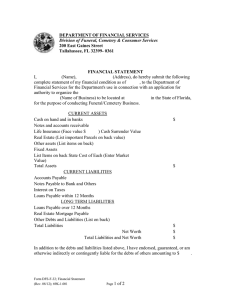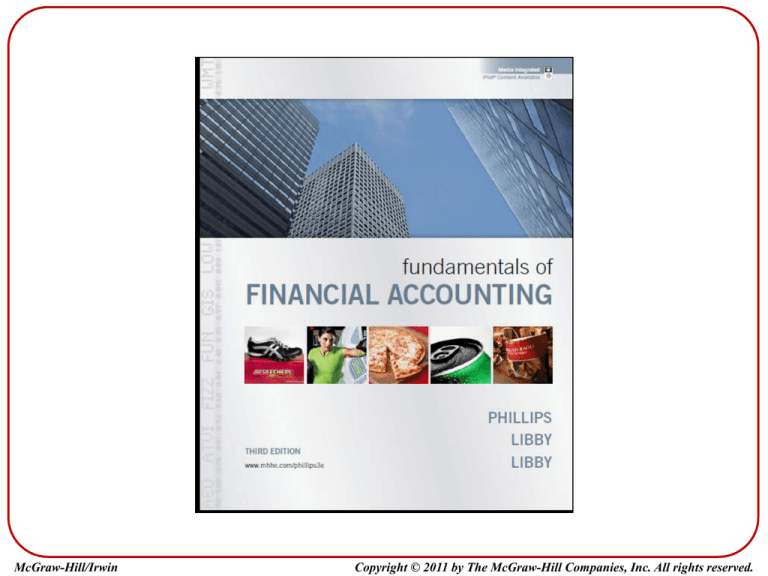
McGraw-Hill/Irwin
Copyright © 2011 by The McGraw-Hill Companies, Inc. All rights reserved.
Chapter 10
Reporting and Interpreting Liabilities
PowerPoint Authors:
Susan Coomer Galbreath, Ph.D., CPA
Charles W. Caldwell, D.B.A., CMA
Jon A. Booker, Ph.D., CPA, CIA
Fred Phillips, Ph.D., CA
The Role of Liabilities
Liabilities are created when a company:
Buys goods
and services
on credit
Obtains
short-term
loans
Issues
long-term
debt
Current liabilities are short-term obligations that will
be paid with current assets within the company’s
current operating cycle or within one year of the
balance sheet date, whichever is longer.
10-3
The Role of Liabilities
The liability section of the General Mills 2007 and 2008
comparative balance sheets.
10-4
Measuring Liabilities
Initial Amount of the Liability
Cash Equivalent
Additional Liability Amounts
Increase Liability
Payments Made
10-5
Decrease Liability
Current Liabilities
Accounts Payable
Increases
(Credited)
Decreases
(Debited)
when a company
receives goods or
services on credit
when a company
pays on its account
Accrued Liabilities
Liabilities that have been incurred but not yet paid.
10-6
Notes Payable
Four key events occur with any note payable:
1. establishing the note,
2. accruing interest incurred but not paid,
3. recording interest paid, and
4. recording principal paid.
10-7
Current Portion of Long-Term
Debt
Long-Term Debt
Current Portion of
Long-term Debt
Noncurrent Portion
of Long-term Debt
Borrowers must report in Current Liabilities the portion of
long-term debt that is due to be paid within one year.
10-8
Additional Current Liabilities
10-9
Sales Tax
Payable
Payments collected from
customers at time of sale create
a liability that is due to the state
government.
Unearned
Revenue
Cash received in advance of
providing services creates a
liability of services due to the
customer .
Long-Term Liabilities
Common Long-Term Liabilities
1. Long-term notes payable
2. Deferred income taxes
3. Bonds payable
Bonds are financial instruments that outline the
future payments a company promises to make
in exchange for receiving a sum of money now.
10-10
Bonds
Balance Sheet Reporting of Bond Liability
Relationships between Interest Rates and Bond Pricing
10-11
Contingent Liabilities
Contingent liabilities are potential liabilities that arise from past
transactions or events, but their ultimate resolution depends
(is contingent) on a future event.
10-12
Evaluate the Results
Two financial ratios are commonly used to assess a
company’s ability to generate resources to pay
future amounts owed:
1. Quick ratio
2. Times interest earned ratio
Quick Ratio =
(Cash + Short-term Investments + Accounts Receivable, Net)
Current Liabilities
Times Interest
=
Earned Ratio
10-13
(Net Income + Interest Expense + Income Tax Expense)
Interest Expense
Bond Premium
Bond premium or discount decreases each year, until it is completely
eliminated on the bond’s maturity date. This process is called
amortizing the bond premium or discount. The straight-line method of
amortization reduces the premium or discount by an equal amount each
period.
Recall our example when General Mills received $107,260 on the issue date
(January 1, 2010) but repays only $100,000 at maturity (December 31, 2013).
Under the straight-line method, this $7,260 is spread evenly as a reduction in
interest expense over the four years ($7,260 ÷ 4 = $1,815 per year).
1 Analyze
Cash
$6,000
Assets
= Interest Liabilities
+ Stockholders' Equity
(1,815)
Cash (-A) -$6,000Amortization
Premiumof
onPremium
Bonds Payable
Interest Expense
(-L)Expense -$1,815 $4,185
(+E, -SE)
$4,185
Interest
2
Record
dr
dr
10-14
Interest Expense (+E, -SE)
Premium on Bonds Payable (-L)
cr Cash (-A)
4,185
1,815
6,000
Bond Premium
Amortization Schedule of Bonds Issued at a Premium
$7,260 - $1,815 = $5,445
$7,260 ÷ 4 = $1,815
$100,000 × 6% × 12/12 = $6,000
$107,260 – $1,815 = $105,445
$6,000 - $1,815 = $4,185
Notice that each of these amounts would plot as a straight-line!
10-15
Effective Interest Amortization
General Mills issued $100,000 face value, 6%, 4-year bonds at a market
price to yield investors 8%. The bonds were issued at a discount of $6,624.
Let’s determine the effective interest for the first interest payment period.
1 Analyze
Interest (I)= = Principal
(P) × Rate (R)+× Stockholders'
Time (T)
Assets
Liabilities
Equity
Expense
= Carrying
Value
× MarketInterest
Rate ×Expense
n/12
CashInterest
(-A) -$6,000
Discount
on Bonds
Payable
$7,470
× 12/12
(-xL, =
+L)$93,376 × 8%
+1,470
(+E, -SE)
$7,470
2
Record
dr
10-16
Cash Interest
$ 6,000
Interest Expense (+E, -SE)
Effective Interest
7,470 7,470
cr Discount
on Bonds Payable
(+xL, -L)$ 1,470
Amortization
of Discount
cr Cash (-A)
1,470
6,000
Effective Interest Amortization
$7,470 - $6,000 = $1,470
$7,470 - $1,470 = $5,154
Effective Interest Amortization of Bonds Issued at a Discount
$93,376 × 8% × 12/12 = $7,470
$100,000 × 6% × 12/12 = $6,000
$93,376 + $1,470 = $94,846
Both Interest Expense and Discount Amortization
increase each period. Cash interest is unchanged.
10-17
End of Chapter 10

